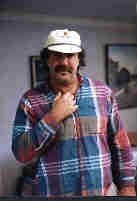
CORONADO STUDIOS
1995-1996 SERIE PROJECT
The following is an extract of an interview with Mr. Pablo
Taboada Camus done by Kelsey Chase, Assistant Director for
Coronado Studios for the purpose of providing biographical
information on Serie artists to create BIOS for press packets
and touring exhibits.
KS. What is your heritage by birth and family history?
PTC. I was born in Santiago, Chile, both of my parents were born in
Chile.
KS. Why do you create?
PTC. Images appear to me or I see a certain scene and I have this
overwhelming desire to put them on canvas, to record the mood. I
suppose it's a way to understand the world around me and my place in it.
KS. What kind of media do you work with?
PTC. Mostly oil on canvas and on board I usually prepare the canvas
and the boards myself The boards I prepare in the old fashioned
way, with rabbit skin glue and powdered marble, and lots of coats
and sanding. I have this urge to begin doing temperas, and probably
will, some-time soon. I like the smell and feel of oils.
KS. What movements, if any, have you been influenced by?
PTC. Living in the U.S., you can't help but be influenced by
American art. I love Hopper and Wyeth, Homer also, Cecilia Beaux,
and also the great Spanish masters, Zurbaran, Velasquez, Goya,
Sanches-Cotan. I also love some contemporary Chilean painters such
as Claudio Bravo and Guillermo Munoz-Vera. These are but a few that
come to mind, there are many others that I love- Milton Avery, for
example for his colors, and Julio Larraz, a contemporary Cuban-
American painter, for his compositions.
KS. How do you perceive art and its role in society?
PTC. Art to me is a communication on an intimate level of who we
are, what we are about. Its an exploration of the self and society,
a record of the exploration of the ebb and flow, of the "in here",
with the "out there".
KS. At what age did you discover the desire, or discover yourself
as an artist? Did that have an impact on how you created?
PTC. My earliest attempts to create finished works were when I was
around 13 or 14. At that time I began a lot of full sheet
watercolors and temperas, (the school type). My work in oils did
not begin until I was around 15 or 16. My first art teacher was
excellent. She encouraged us to be free and expressive, and to try
different techniques and approaches.
KS. If you are self-taught, talk about your growth as an artist.
PTC. I was "self taught" in oil painting until my late twenties.
At that time I met James Kramer, a master technician in watercolor.
He encouraged me to study painting with master painters and to
learn the craft inside and out. Since then I have taken classes
with many excellent painters. Some of the more important ones to my
painting were David Leffel and Sherrie McGraw, who taught at the
Arts Students League in NY. Sunny Appinchapong, who studied under
Sergei Bongrt, a Russian master, and Clyde Aspevig, a premier
landscape painter. David and Sherrie teach a classical chiaroscuro
technique, a very painterly and poetic style. Sunny Appinchapong
teaches a very different approach, very direct, impressionistic,
with an emphasis on color temperature and value, seen from nature
and painted alla prima. Clyde Aspevig is a premier self taught
painter from Montana, his paintings have very crisp color and
value, with an emphasis on texture and mood. He likes camping and
getting out there. My painting is a combination of these important
influences applied to a more classical subject matter. For example,
my still lives are traditionally Spanish in style, although I like
to put a touch of the modern in there as well. Painting common
objects and trying to give them spiritual, metaphorical ambience,
but also trying to evoke texture. I spend many hours observing the
object, and treat to create it in paint, not just copy it. I also
love painting the effects of light.

